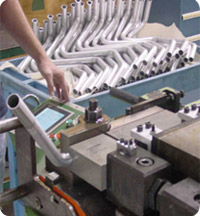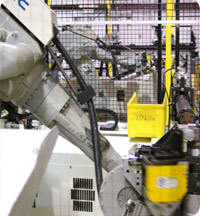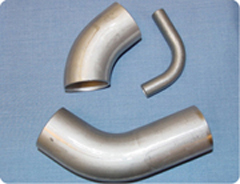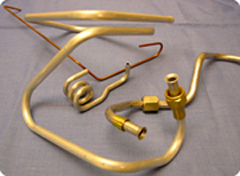





We have the equipment and tooling to bend tubing from .125” to 3.00” diameter in most metals. We primarily use the Rotary Draw Bending method, where the tube is drawn around a bend die. This is done with or without a mandrel.

Mandrel tube bending is used to produce tubes with minimal collapse in the bend area. This is most often used in tight radius and thin tube wall applications or where a constant flow area is critical to the performance of the product. It is also used in decorative applications with demanding visual requirements. This method is often more expensive than other bending practices due to the complexity of the tooling and set-up processes and because it is more difficult to automate loading and unloading. In addition, post-bending cleaning processes are usually required to remove drawing lubricant used during bending. This method is commonly used in intake and exhaust pipes, aircraft components, and hand rails.

Many smaller diameter tubes can be bent successfully without a mandrel while maintaining acceptable levels of collapse and distortion in the bend area. This is accomplished by using specialized tooling and selecting the proper material and bend radius. By eliminating the use of a mandrel, parts can be easily processed with robotics and automated equipment and may not require any clean-up of bending lubricants. We use this method to produce oil lines, fuel lines, hydraulic lines, oxygen lines, and many other fluid and gas tubes.

Simple bent parts are either supplied to the customer “as bent” or with specific trimmed leg lengths. These parts are most often produced for clients that are working on prototypes where final dimensions and features have not been determined or in very small-volume niche industries where tubes are being hand-fit for each application. We also produce bent and trimmed tubes for exhaust system manufacturers who assemble and weld the parts into finished exhaust headers and collectors.

Through the use of robotic and CNC tube bending equipment, we can produce very complex tubular components. We can reverse engineer samples with our sophisticated measuring equipment or use customer-supplied models and CAD data to create part programs. Inspection can be accomplished with a non-contact tube measuring machine or with functional gages.